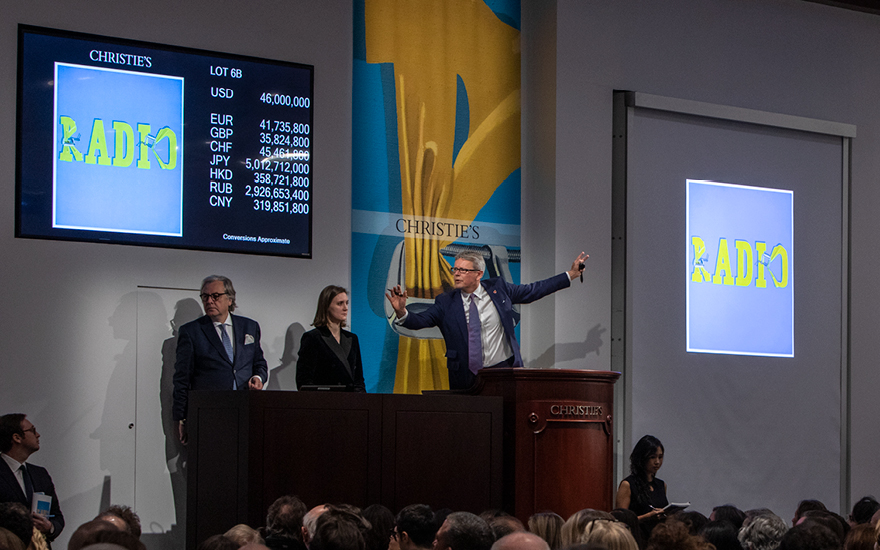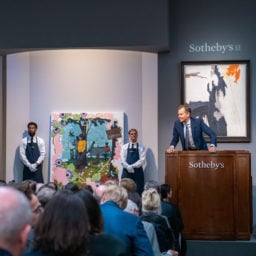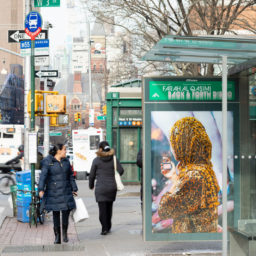On Friday, as galleries and museums around New York started closing en masse to prevent the spread of coronavirus, the major auction houses in the city were silent. Then, at around 8 p.m., Christie’s sent out a notice that most of its offices around the world would close, many sales would be called off through April, and its forthcoming calendar would be reviewed—but, at least for now, it has not yet postponed its bellwether Modern and contemporary art sales in New York in May.
Phillips was more precautionary, closing offices in the US and Europe and delaying its 20th-century and contemporary art evening sale, which typically runs as part of New York’s May auction week.
Sotheby’s, meanwhile, took the most lenient approach of all. No sales would be cancelled, including the design and photography sales set to be held in New York—live from the York Avenue sales room, with the rostrum packed with specialists—in less than three weeks. None of its galleries would be closed to the public.
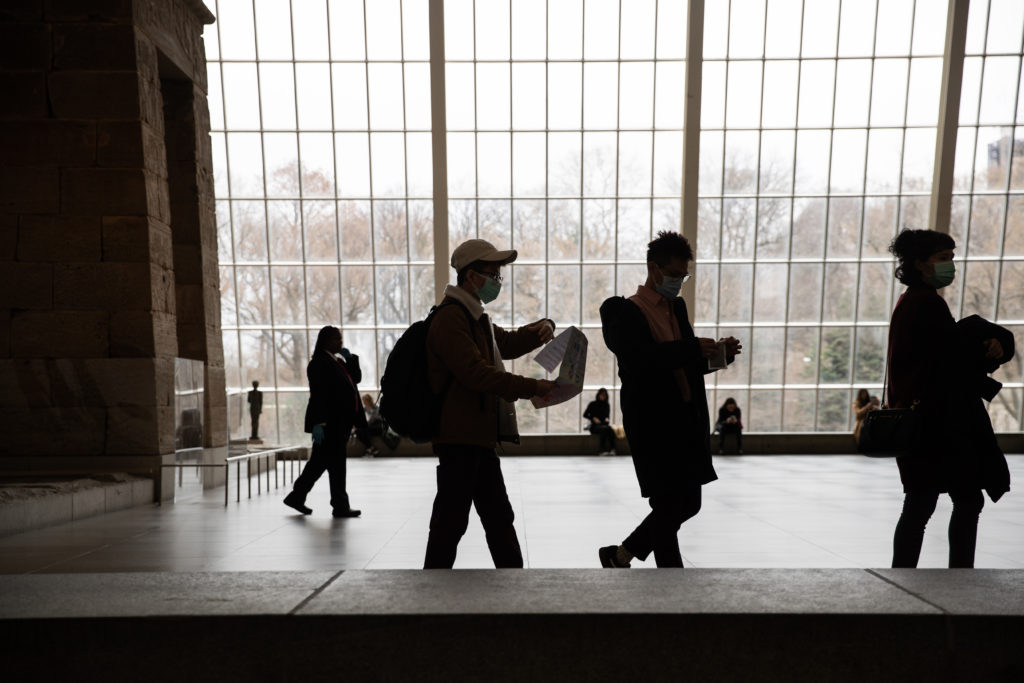
Tourists wearing protective masks at the Metropolitan Museum of Art on March 10, 2020 in New York City. The museum announced it would close Friday because of the COVID-19 pandemic. (Photo by Jeenah Moon/Getty Images)
Rather than urge art-lovers to self-isolate to prevent the spread of the disease to the more vulnerable, Charles F. Stewart, the CEO of Sotheby’s, encouraged the public to see exhibits at Sotheby’s in New York and London (“a particularly inventive exhibition that shouldn’t be missed!” he said of a show in London, exclamation point Stewart’s). “Over those nearly three centuries, we have successfully managed through all manner of circumstances—from world conflicts to market downturns—and we will manage in this instance as well,” he said.
Keeping Course in the Storm
That sentiment now seems like it’s a world away—a testament to how quickly both official regulations and social mores are changing. On Monday, New York Governor Andrew Cuomo banned all gatherings of more than 50 people, following the Center for Disease Control’s earlier message that such limits on crowds be in place for at least eight weeks. With the virus expected to not peak for months, it’s become impossible to image a scenario in which an auctioneer presides over a packed salesroom, flanked by specialists spewing phlegm into their phones.
And yet, the two members of the global auction house duopoly insisted that, by hook or by crook, their blockbuster sales would go on. As of now, the springtime spree of conspicuous consumption that’s often dubbed a “gigaweek”—in the past, the houses have grossed billions of dollars between them in a matter of days—would proceed.
By Monday night, Christie’s issued the same statement it put out on Saturday, noting that “we continue to assess the situation daily and make appropriate arrangements to help ensure the health and safety of employees and visitors to our salerooms and galleries worldwide.”
“Christie’s is currently working through a restructuring of its forthcoming auctions, including significant changes to the sales calendar in the Americas and Europe. In the meantime, the following sales scheduled for March and April are postponed, with the announcement of new dates to come shortly,” the statement continued.
And late Monday, Sotheby’s sent out a notice indicating that it would take the auctions that it had previously moved from a coronavirus-panicked Hong Kong to a then-safe New York—and move them back to Hong Kong, now in July. (Other changes include indefinite postponements of a number of Paris auctions.) But the bellwether May sales would stay on the schedule, expected to be held as if we lived in normal time. Any changes to that plan will be made 30 days before the event, Sotheby’s announced.
“Sotheby’s is technologically equipped to operate in a variety of scenarios and, based on conversations with both consignors and bidders, we are considering a number of formats to provide for sales to proceed in the most effective manner,” the house said in a statement.
Postpone to Summer?
Even if the sales have not been officially cancelled, given the restrictions in place—and the real chance that they get much, much worse—several advisors said that at the very least, the sales would have to be postponed.
One suggested that the May evening auctions be pushed to June, a month which will almost definitely have a big hole left by an expected-to-be-pushed Art Basel in Switzerland. In the past, the auctions had come right after Frieze New York, but given that fair’s rumored postponement or cancellation, Christie’s and Sotheby’s wouldn’t lose anything by moving to another, more auction-centric month.
“June is already a sale season due to the fact that London has their sales in June,” said one advisor when reached on the phone—or rather, via FaceTime audio, due to the poor cell signal in remote locations members of the art community have escaped to. (Like other advisors quoted in the story, this one requested anonymity; the world might be ending, but there’s no reason to anger the world’s biggest auction houses before it does.)
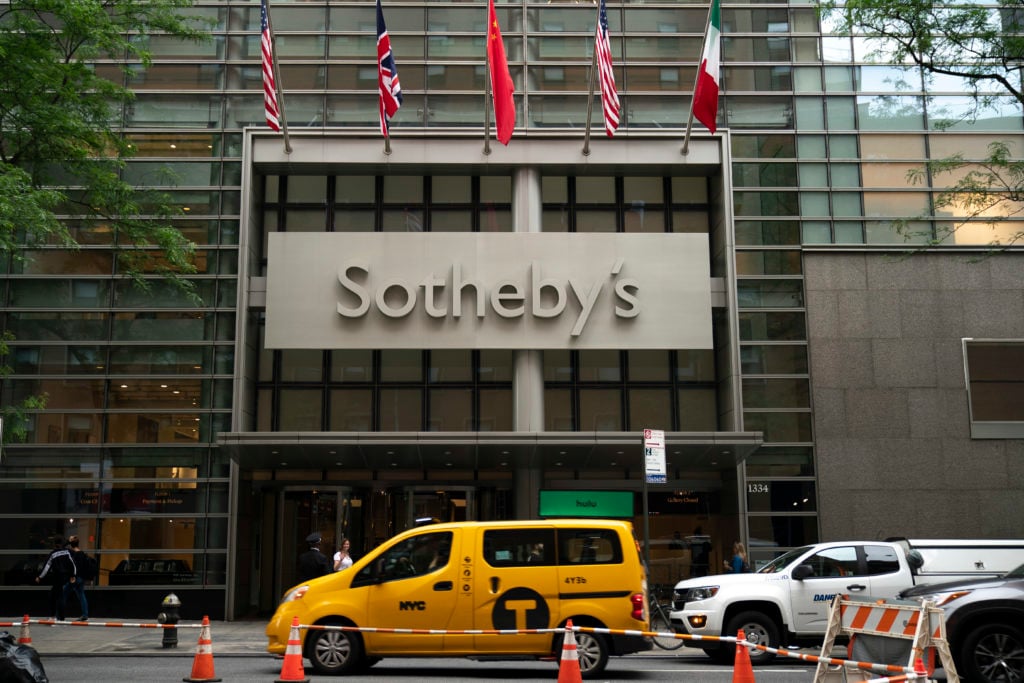
Sotheby’s headquarters on the Upper East Side in Manhattan. (Photo by Drew Angerer/Getty Images)
Social-Distance Auctions?
Postponement is a natural response, though perhaps an optimistic one. Who knows if gatherings of more than 50 people will be allowed by June, especially if the president has said that our previous way of life will not return in full until July or August? One option floated was to have the auctions live-streamed with just an auctioneer but no audience, presidential debate style, and a few specialists the mandated six feet away from them (perhaps in some Saville Row-designed hazmat suits). Collectors could watch from the Hamptons and bid through their favorite specialist. Don’t the real buyers opt not to show up anyway, and have their surrogates do the dirty work?
Art Basel’s online viewing room, which opens this week, could offer a model for high-priced virtual art purchasing. But several advisors pointed out that the scheme might not work for sales that were expected to feature eight-figure lots from collections as high-profile as Linda and Harry Macklowe’s. Such pictures would almost certainly be pulled.
“What consignor would want their property sold under such circumstances?” one advisor said.
No Sale, No Overhead
There’s also the problem of condition reports. One source explained that, while a good chunk of collectors pre-buy work from dealers prior to the VIP openings of fairs solely based on seeing JPEGs on an iPad, that is almost always primary work straight from an artist’s studio, where condition is rarely an issue. Most collectors would want to see a work that has passed through many hands up close before spending millions.
While it would be bad for optics momentarily, the more logical—and overwhelmingly safer—choice would be to cancel the sales entirely. There could even be a silver lining in that, while the prices will be lower than they were last November, deal-seeking collectors would be able and willing to buy works privately. (The fate of the Marron collection has already proven that to be a fruitful direction.)
That way, houses can avoid having to come up with estimates for every lot as well as the entire business of compiling and printing auction catalogues. Even a live-streamed sale could be a little pricey—not to mention poor optics if a number of works are bought in. “A better use of their skill set and human capital is getting their best people targeting work and brokering private sales,” said another advisor.
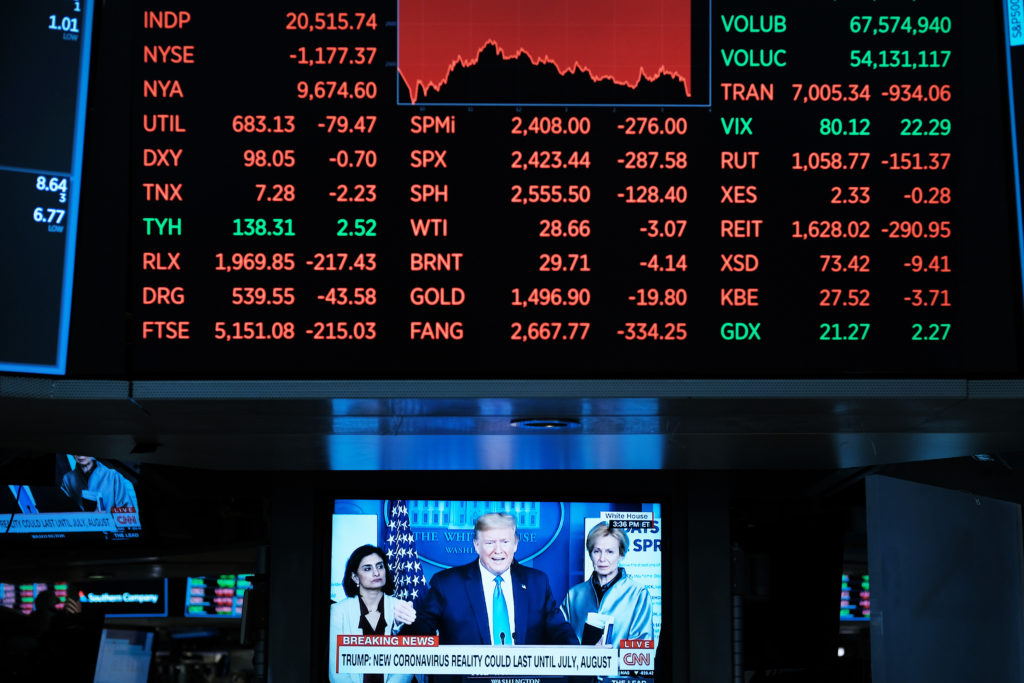
President Trump is displayed on a television on the floor of the New York Stock Exchange (NYSE) on March 16, 2020 in New York City. Stocks again fell sharply on Wall Street despite a drop in interest rates. (Photo by Spencer Platt/Getty Images)
“Radio Silence”
More than mere speculation, sources expressed an overwhelming sense of dread about where the art economy is headed. Several compared what is happening now to the 2008 recession, while others mentioned 9/11. There is a feeling that the economy won’t bottom out until there’s a realistic idea of how many people are going to be affected by the disease, and how hard cities will be hit. There’s a fear that Monday’s 3,000-point drop in the stock market might not be the worst of it. I asked one dealer how business has been in the last week. “Radio silence,” they said.
For that reason, another dealer said that any attempt to hold a major auction—whether it in a new location or streamed live online—is likely to be a major loss. “They can hold the things in space,” the dealer said, “but if no one feels in the mood to buy art, does it even matter the format?”
